AMD 3rd Gen EPYC Milan Review: A Peak vs Per Core Performance Balance
by Dr. Ian Cutress & Andrei Frumusanu on March 15, 2021 11:00 AM ESTDisclaimer June 25th: The benchmark figures in this review have been superseded by our second follow-up Milan review article, where we observe improved performance figures on a production platform compared to AMD’s reference system in this piece.
SPEC - Multi-Threaded Performance
Picking up from the power efficiency discussion, let’s dive directly into the multi-threaded SPEC results. As usual, because these are not officially submitted scores to SPEC, we’re labelling the results as “estimates” as per the SPEC rules and license.
We compile the binaries with GCC 10.2 on their respective platforms, with simple -Ofast optimisation flags and relevant architecture and machine tuning flags (-march/-mtune=Neoverse-n1 ; -march/-mtune=skylake-avx512 ; -march/-mtune=znver2). For the new Zen3 Milan parts, as GCC 10.2 at the time didn’t have support for the new microarchitecture, we’re using the same Zen2 binaries as on Rome, as otherwise we’d have to rerun all numbers on all platforms with a newer GCC 11 baseline – something we will do in the future but out of the scope of this piece.
In terms of data-points, we’re comparing the new 7763 against a 7742, as well as the top socketed SKUs from the competition, including a Xeon 8280 (Equivalent to a Xeon 6258R), and Ampere’s Arm-based Altra Q80-33. It’s to be noted that the 7763 is a 280W part, and thus lands in higher than the other three chips, but we wanted to compare the top of the stack with the best available parts we had available for testing.
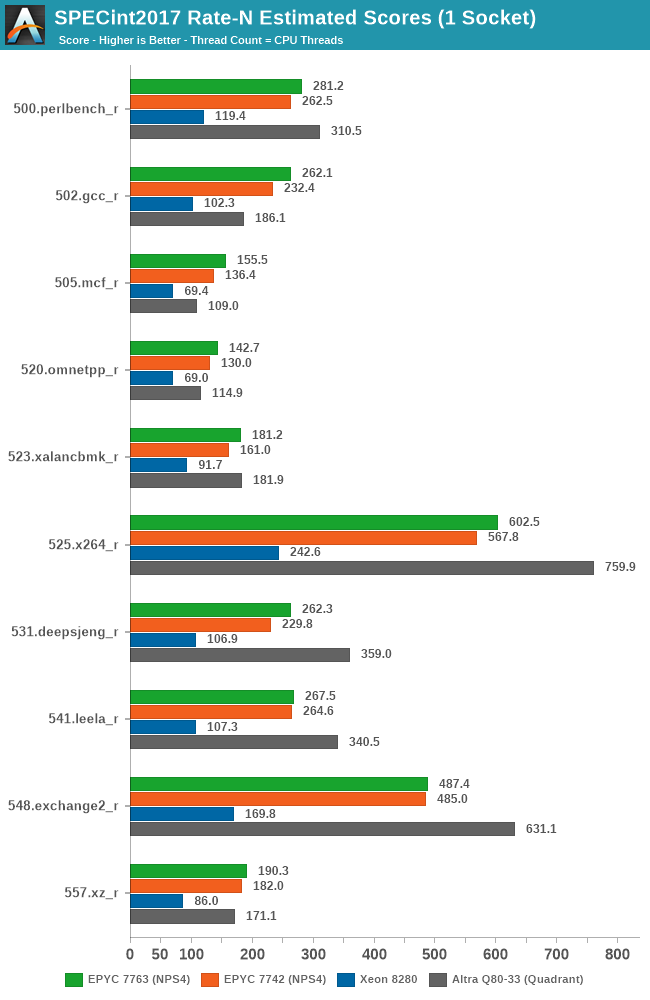
Generationally, the new 7763 does outperform the 7742 across the board, but generally the magnitude isn’t quite as large as you’d expect given the 40W higher TDP of the chip – a performance delta that gets even tighter when configuring the 7742 to a 240W cTDP.
Against the competition, AMD’s traditional adversary Intel doesn’t really stand a chance as the Milan chip is posting well over double the performance in almost all workloads.
The newer competition AMD should worry about is Ampere’s new Altra system – which currently still outperforms the top-end Milan based 7763 in several compute-heavy benchmarks by notably margins. In more memory-heavy workloads, the EPYC more easily beats the Altra due to having essentially 8x the total cache per chip at 256MB vs 32MB.
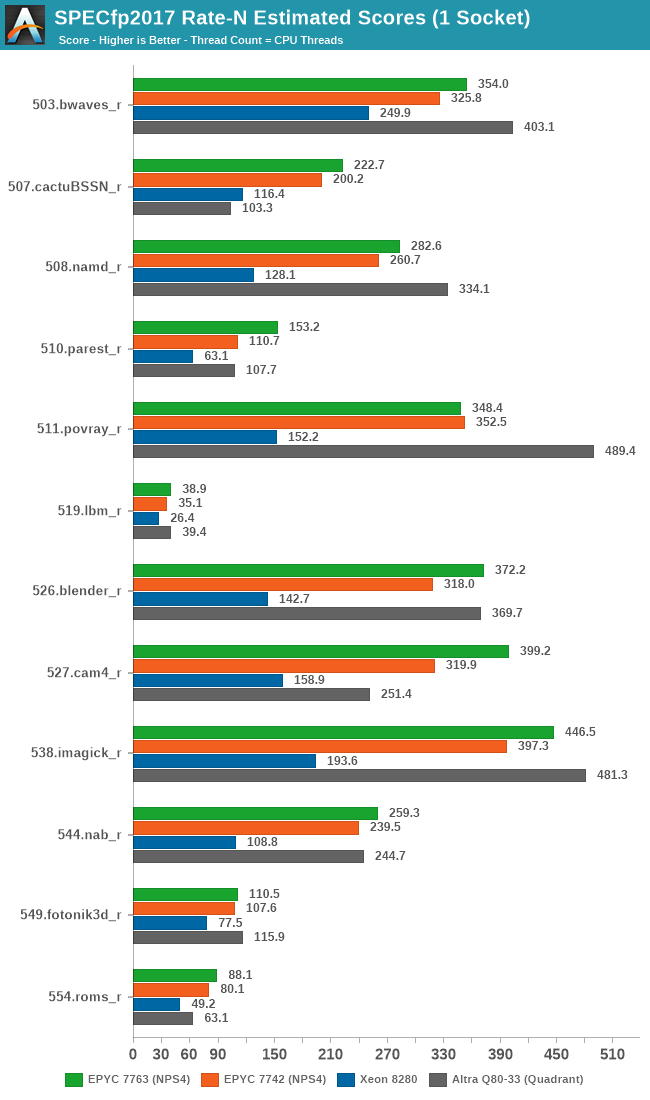
We’re seeing a similar story in SPECfp2017, more oriented towards HPC workloads. The one result that stands out here is 511.povray, in which the 7763 loses out to the previous generation 7742 due to the workload being more core-bound, and the Milan chip having a lesser effective thermal envelope available for the cores, even at the higher 280W TDP.
Intel’s 8280 again really isn’t a viable competition to AMD’s chips, with the Ampere Altra being a closer match for AMD’s EPYC, winning some, losing some.
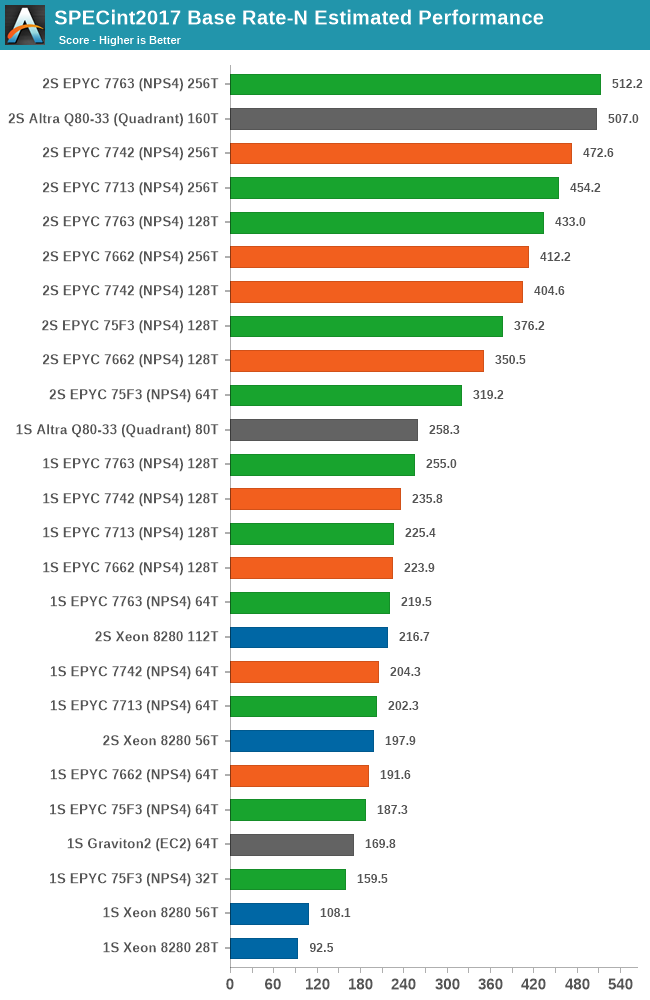
With Milan, AMD is now retaking the performance lead in SPECint2017, although by only a small margin.
Generationally, the EPYC 7763 is 12.8% faster than the 7742 – unfortunately we don’t have figures of the corresponding 280W 7H12 Rome part.
Comparing the 7713 against the 7742, things aren’t looking as great, as the new Milan part sees a 4% performance regression. It’s to be noted again that AMD had claimed the 7713 is a direct successor to the 7662, where it does fare 10% better, however that is a $900 cheaper part.
Amongst the rather luke-warm results of the top-stack Milan SKUs, one result that stands out more is the 32-core frequency optimised 75F3 SKU. Featuring only half the cores, the part still manages to easily compete amongst its 64 core siblings, showcasing 82% of the performance of a 7713. This has rather large implications for per-thread performance of this part which we’ll cover in a later page.
Although AMD’s presentation slides using totally different SPEC result numbers due to very different compiler and optimisation settings, the actual relative positioning we are getting in our internal results actually exceed that of what AMD is presenting, with the 7763 coming in with a +128% advantage over the Intel 8280, a part that’s performance equivalent to the 6258R.
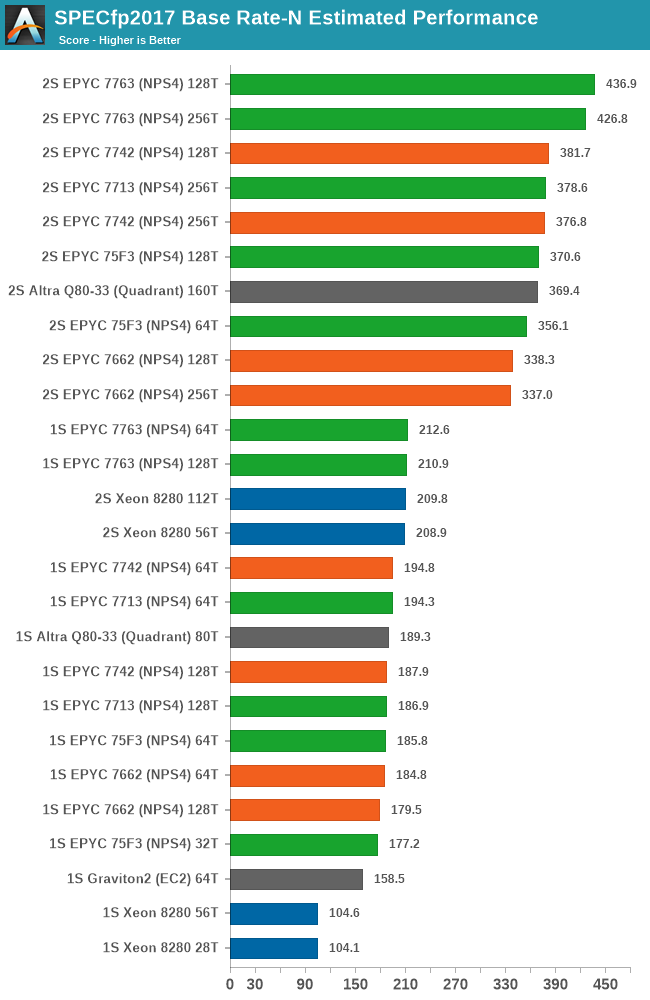
In the SPECfp2017 suite which is more representative of HPC workloads and has a focus more towards memory performance, AMD had always retained their performance leadership, and has now widened it with the new Milan generation. The 7763 performs 14.4% better than the Rome 7742, while the 7713 almost outperforms it by a margin of error.
It’s again the 75F3 which is actually stealing the show, as it manages 97.8% of a 7713, and 85.8% of a 7763 even though it has only half the cores.
Against the competition and the figures AMD is showing, we’re measuring the 7763 outperforming the 8280 by 108% - near to the 106% the presentation material is showcasing. Intel should be able to make a larger leap with the next generation Ice Lake-SP server chips as the company moves from 6-channel to 8-channel memory, though we’ll have to see if that’s actually enough to catch up to AMD.


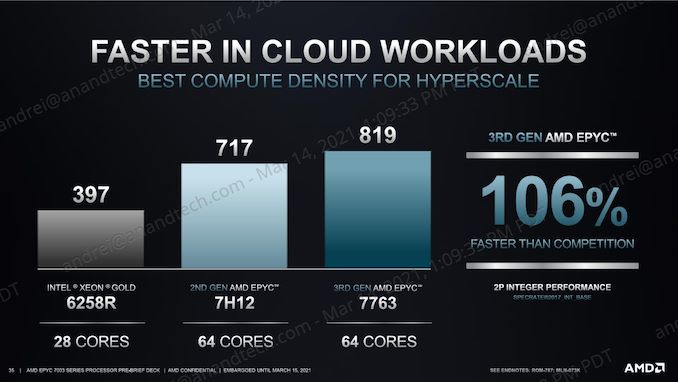
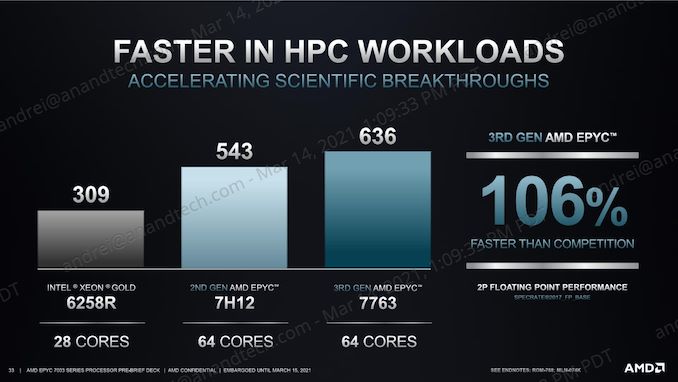








120 Comments
View All Comments
mode_13h - Saturday, March 20, 2021 - link
Okay, thanks for confirming with them.mode_13h - Saturday, March 20, 2021 - link
It's not the easiest thing to confirm with a test, since you'd have to come along behind the writer and observe that a write that SHOULD still be in cache isn't.CBeddoe - Monday, March 15, 2021 - link
I'm excited by AMD's continuing design improvements.Can't wait to see what happens with the next node shrink. Intel has some catching up to do.
Ppietra - Tuesday, March 16, 2021 - link
Can someone please explain how is it possible that the power consumption of the all package is so much higher than the power consumption of the actual cores doing the work?Spunjji - Friday, March 19, 2021 - link
Because the I/O die is running on an older 14nm process and is servicing all of the cores. In a 64-core CPU, the per-core power use of the I/O die is less than 2W. Still too much, of course, but in context not as obscene as it looks when you look at the total power.Elstar - Tuesday, March 16, 2021 - link
Lest it go unsaid, I really appreciate the "compile a big C++ project" benchmark (i.e. LLVM). Thank you!Spunjji - Tuesday, March 16, 2021 - link
"To that end, all we have to compare Milan to is Intel’s Cascade Lake Xeon Scalable platform, which was the same platform we compared Rome to."Says it all, really. Good work AMD, and cheers to the team for the review!
Hifihedgehog - Tuesday, March 16, 2021 - link
Sysadmin: Ram? Rome?AMD: Milan, darling, Milan...
Ivan Argentinski - Tuesday, March 16, 2021 - link
Congrats for going more in-depth for the per-core performance! For many enterprise buyers, this is the most (only?) important metric. I do suspect, that in this regard, the 8 core 72F3 will actually be the best 3rd gen EPYC!But to better understand this, we need more test and per-core comparisons. I would suggest comparing:
* All current AMD fast/frequency optimized CPUs - EPYC 72F3, 73F3, ...
* Previous gen AMD fast/frequency CPUs like EPYC 7F32, ...
* Intel Frequency optimized CPUs like Xeon Gold 6250, 6244, ...
The only metric that matters is per-core performance under full *sustained* load.
Exploring the dynamic TDP of AMD EPYC 3rd gen is also an interesting option. For example, I am quite curious about configuring 72F3 with 200W instead of the default 180W.
Andrei Frumusanu - Saturday, March 20, 2021 - link
If we get more SKUs to test, I'll be sure to do so.